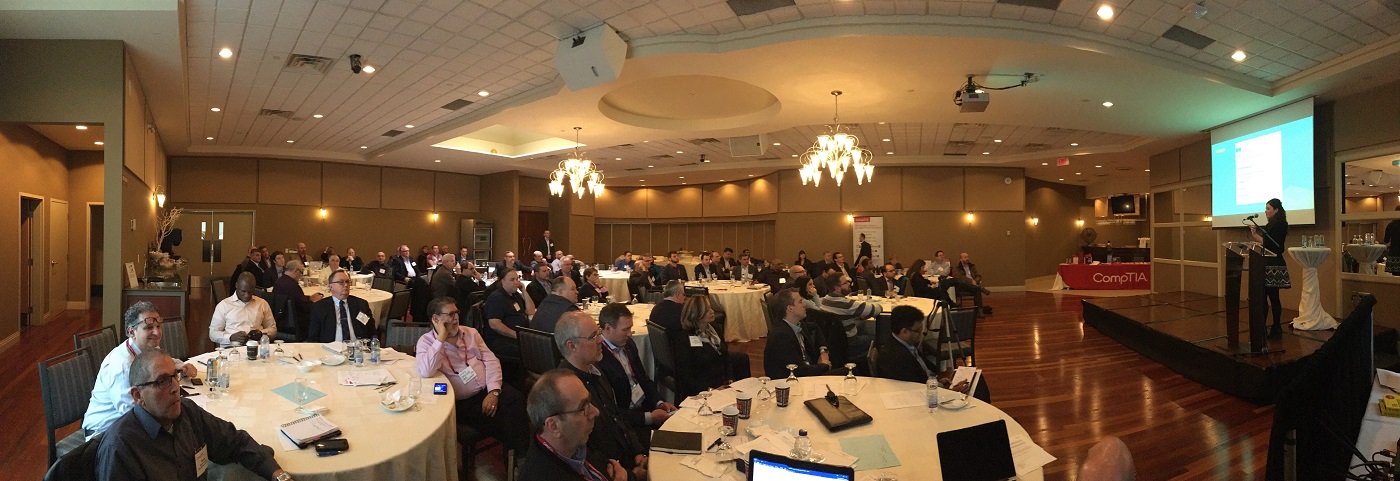The recently released CompTIA IT Industry Outlook report revealed that optimism abounds in the channel, with 62 percent of surveyed firms saying they were successfully reaching new customers. More than half (53 percent) also indicated they were increasing wallet share with their existing clients. Many indicated they were seeing positive results from the launch of new business liens and from efficiency improvements within internal operations.
The startling number revealed only 35 percent of optimists mentioned advancing their sales and marketing processes, despite an obvious reliance on both to reach new customers and gain more revenue from current clients. That dichotomy was at the heart of many discussions and presentations during the February 23 CompTIA Canadian IT Business Community meeting in Toronto.
Chris Groot, VP of Business Development for LogicNow, kicked off the day on a high note, suggesting the tech industry is alive and well based on the results of the latest research. As he noted, Canada’s more than $140 billion piece of the $3.8 trillion global market is chugging along quite nicely despite the short-term investment challenges in the oil and gas sector (cutbacks due to reduced revenue from low prices). CompTIA projects the IT sales to increase another three-four percent in 2016.
Industry Outlook is Positive
Why such optimism in the channel? The connection with customers is getting tighter and providers who understand that linkage, from their executives to their sales and marketing staff, are prospering. “It’s all about the software and user experience today,” stressed Tamer Farag, marketing director for Microsoft during the kickoff Power Panel session. “There is business for everyone in the IT industry, but disrupting technologies are driving change and we have to do things differently.”
Solution provider Brendan Howe, president and CEO of Techify is “looking at double digit growth this year. The trend with our customers is investing in IT that drives their companies’ growth. They don’t want to add helpdesk and mainstream IT staff, but they do want to put their money into things that give them a competitive advantage.”
The key to driving that type of growth is to focus more efforts on sales and marketing, and the research shared earlier shows many providers still aren’t giving those areas enough attention. With the right emphasis and effective procedures, even the smallest of IT firms can reap significant opportunities. “Our number one partner in Canada is a two-person operation,” stressed panelist Danny Deganis from Arcserve. “The owner is a consummate networker and works his rolodex well. They engage with us (one of their vendor partners) as an extension of their sales team, which keeps his overhead. We offer subject matter expertise and help him push the sale.”
Commoditization and poor business practices remain top challenges. Howe suggested that improvements to one side of the house might lessen the profitability issue. “The reason we’re driven down in pricing? Customers don’t understand what we’re delivering and the infrastructure we have in place to support their organization, how complicated and costly it is to deliver. The challenge we all have is getting better explaining it properly, helping customers appreciate the differences between companies so they will be willing to pay more for quality services and support.”
Channel organizations often have to do the best they can with the resources they have available, at least until they can build out their clientele, their programs and their people. Julian Lee, president of Technoplanet suggested that HR is one of the biggest issues providers face today. “You have to look hard to find talent and then, when you find it, retention becomes an even bigger problem. Of course, you can outsource certain elements of the business. There may be no need to find a talent pool of your own when you can get good rates and quality partners who can help deliver quality services. That’s just one way providers are solving the HR problem.”

Are You Delivering a Quality Customer Experience?
The Power Panel discussion uncovered some key issues facing channel companies, including the need to get better connected to the customer. As speaker Phil Sager, Principal of Bain & Company suggests, those links take more time and resources to establish than many companies are willing to commit. “Just having a net promoter score or other data won’t lead to tangible improvements. The company has to make a strategic commitment to strengthen its processes and convey those changes in a common, simple language. They need to use trusted data and employ a proven feedback system, but employees are the key to winning customers’ hearts and minds.”
Attention to detail is crucial, as is having the feet on the street to engage and elicit reactions (both positive and negative). The sales and support teams are typically closest to the front in channel organizations, while the strategy is often driven from the top down. When the leadership team isn’t properly aligned with and committed to a customer relationship improvement system, it’s unlikely to work. That’s especially true when the first responders don’t have the power to resolve client issues quickly or at all due to lengthy communications and approval processes.
What key question does Sager believe needs to be asked, that often isn’t? “Would you recommend us to a family member or a friend? You have to create that mindset throughout the organization to succeed.
A Day of Channel Engagement
One of the benefits of attending a CompTIA Canadian IT Business Community meeting is spending time with their peers and collaborating on key issues facing the industry. Following an engaging risk assessment and management discussion with Samantha Ciaccia, vice chair of the CompTIA Cloud Community and channel engagement manager for Datto, attendees broke into six groups to brainstorm on a number of channel-related issues and opportunities.
The consensus? One group summarized it well: “change is happening rapidly and providers who embrace change are going to be more likely to succeed.” Their biggest concerns included limited resources, including a limited number of skilled professionals to support the rapidly growing number of services providers have to offer. Sales team development is another struggle. It’s not easy to identify and attract those with the level of relationship-building skills needed to succeed with managed and cloud services. Outsourcing can fill in some of the tech skills, but training, mentoring and coaching is needed across the board.
Can the channel attract more Millennials and women to help meet the increasing labor demand? Will training and certifications help boost the IT talent pool over the next few years? Time will tell, but the efforts of peer groups such as the CompTIA Future Leaders Community and the Advancing Women in IT Community aren’t going unnoticed in meetings such as this.
At the end of the day, attendees had an opportunity to discuss their own challenges and opportunities, and network with a number of industry thought leaders. The CompTIA team was able to point them towards useful resources and make introductions that may foster new business relationships. That’s what community is all about. Interested in joining the conversation? Simply register on the community page (it’s free) to be invited to their upcoming online and live events.

Engage to Better Innovate: Channel Focus Emphasizes More Business, Less Technology
Email us at [email protected] for inquiries related to contributed articles, link building and other web content needs.
Read More from the CompTIA Blog
Newest on top
Oldest on top

